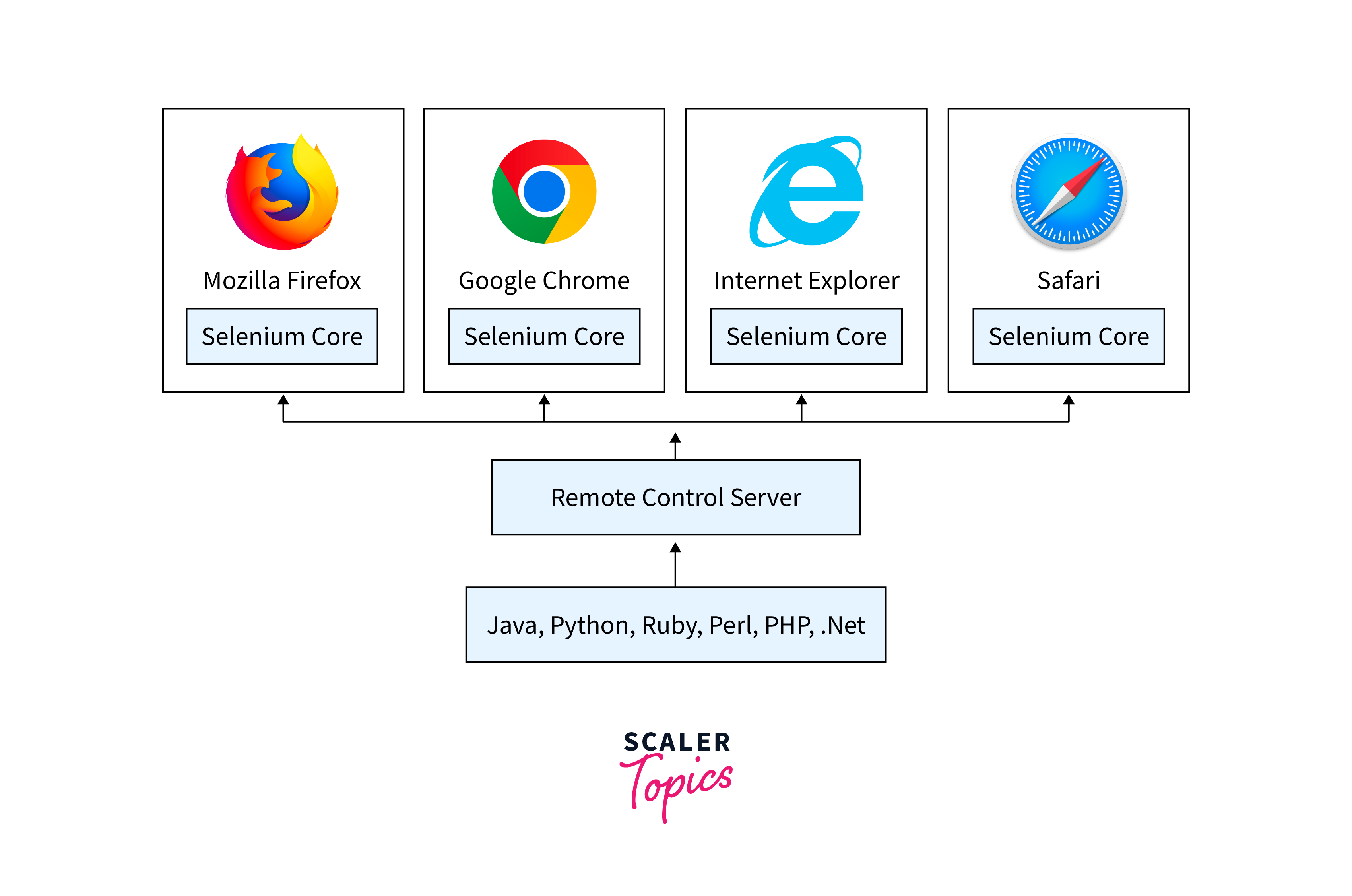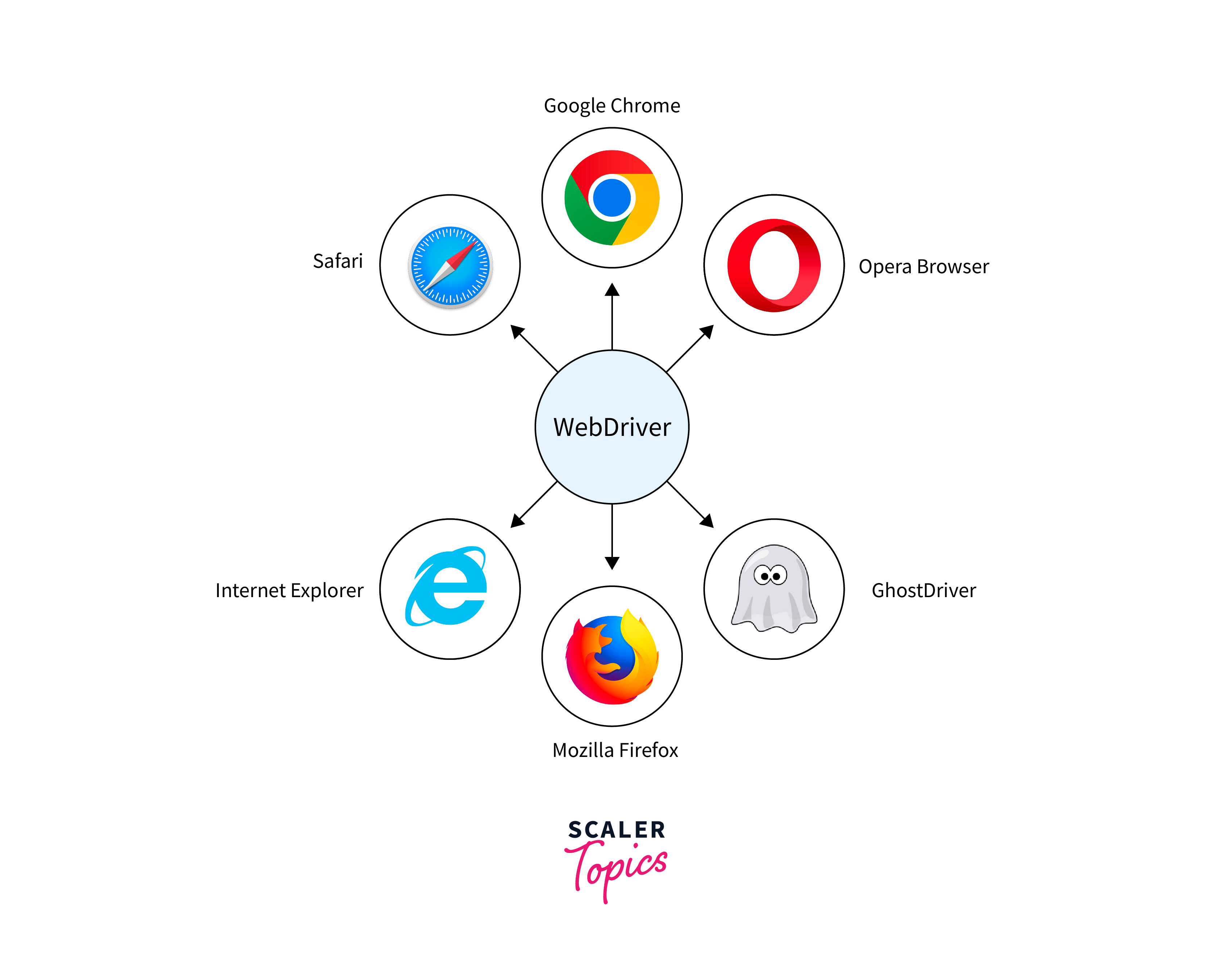Selenium RC vs Selenium WebDriver
Overview
Selenium RC (Remote Control) was the first version of Selenium that allowed executing tests on remote machines. However, it had limitations and required an additional server for test execution. Selenium WebDriver, on the other hand, is an improved version that provides a simpler and more powerful API for interacting with web elements, eliminating the need for a separate server and enabling faster and more stable test automation.
Selenium RC (Remote Control)
Let's explore Selenium RC in detail:
Explanation of Selenium RC
Selenium RC (Remote Control) was the predecessor to Selenium WebDriver and is an older version of the Selenium framework. It provides a way to automate web browsers by injecting JavaScript into the browser using a separate Selenium RC server.
Some of the components of Selenium Remote Control include:
-
Selenium RC Server:
The server is a proxy between test scripts and the browser.
-
Client Libraries:
Language-specific libraries for interacting with the Selenium RC Server.
-
Test Scripts:
Automation scripts written in programming languages like Java, C#, Python, or Ruby.
-
Selenium Core:
JavaScript-based automation engine used for injecting and executing JavaScript commands in the browser.
-
Remote Control API:
APIs that allow communication and interaction with the Selenium RC Server.
-
Browser Drivers:
Components that enable Selenium RC to interact with different browsers and browser versions.

Advantages of Selenium RC
While Selenium WebDriver is the recommended approach for web automation, Selenium RC (Remote Control) does have a few advantages:
-
Support for Multiple Languages:
Selenium RC supports many programming languages, including Java, C#, Python, Ruby, and more. This allows testers to write automation scripts in their preferred language.
-
Flexibility in Test Execution:
Selenium RC enables running tests in different browsers and operating systems by utilizing Selenium Grid. This allows for cross-browser and cross-platform testing.
-
Backward Compatibility:
Selenium RC is backward compatible with older versions of Selenium. If you have an existing Selenium RC codebase, it can still be used without major modifications.
Limitations of Selenium RC
Here are some of the limitations of Selenium RC:
-
Dependence on External Server:
Selenium RC requires an additional server called the Selenium RC Server to be started before executing tests. This adds complexity and an extra step in the setup process.
-
Performance Issues:
Selenium RC suffers from performance issues due to its architecture. It relies on JavaScript injection to interact with the browser, which can result in slower execution times compared to Selenium WebDriver.
-
Cross-Browser Compatibility:
Selenium RC may encounter difficulties achieving reliable cross-browser compatibility. It relies on JavaScript-based automation, which may be inconsistent across different browsers, leading to flaky and unreliable test results.
-
Limited Browser Support:
Selenium RC has limited support for newer browser versions. Selenium RC may need help maintaining compatibility as browsers evolve and introduce changes, leading to issues and inconsistencies.
-
Maintenance Challenges:
Selenium RC has been deprecated and is no longer actively maintained. It may not receive updates, bug fixes, or support for newer browser versions. Maintaining a codebase built on an outdated and deprecated framework can take time and effort.
-
Complex Test Scripting:
Selenium RC requires more complex test scripting than Selenium WebDriver. It uses different commands and methods, making the test scripts harder to read, understand, and maintain.
Selenium WebDriver
Let's have an overview of Selenium Webdriver:
Explanation of Selenium WebDriver
Selenium WebDriver is a popular open-source framework for automating web browsers. It provides a programming interface to interact with web elements, simulate user actions, and perform automated testing on web applications. WebDriver allows testers and developers to write scripts in various programming languages, such as Java, Python, C#, Ruby, and more, to automate browser actions.

Advantages of Selenium WebDriver
Selenium WebDriver is the recommended approach for web automation and offers several advantages:
-
Simplified Architecture:
Selenium WebDriver has a simpler architecture than Selenium RC. It directly communicates with the web browser, eliminating the need for a separate server and reducing the complexity of the setup process.
-
Improved Performance:
Selenium WebDriver provides faster and more efficient test execution. It interacts with the browser using native browser automation APIs, resulting in improved performance and reduced overhead compared to Selenium RC.
-
Enhanced Browser Compatibility:
Selenium WebDriver has excellent cross-browser compatibility. It supports multiple browsers, including Chrome, Firefox, Safari, Edge, and more. WebDriver ensures consistent behavior across different browsers, allowing for comprehensive testing.
-
Support for Multiple Programming Languages:
Selenium WebDriver supports multiple programming languages, such as Java, C#, Python, Ruby, and JavaScript. This flexibility allows testers to use their preferred language for writing automation scripts.
-
Powerful and Rich API:
WebDriver provides a powerful API for interacting with web elements and performing various actions. It offers various methods to locate elements, perform clicks, fill forms, handle alerts, and validate page content, enabling comprehensive test coverage.
Limitations of Selenium WebDriver
While Selenium WebDriver is a powerful tool for web automation, it does have some limitations:
-
Limited Support for Non-Web Applications:
Selenium WebDriver is primarily designed for web application testing and does not provide native support for automating non-web applications like desktop or mobile.
-
No Built-in Test Reporting:
Selenium WebDriver does not have built-in test reporting capabilities. Test results and reports must be handled through external libraries or frameworks such as TestNG, JUnit, or custom reporting solutions.
-
No Support for CAPTCHA and OTP Handling:
CAPTCHA and OTP (One-Time Password) are security measures implemented by websites to verify that the user interacting with the application is a human and not a bot. Selenium WebDriver cannot handle CAPTCHA (Completely Automated Public Turing test to tell Computers and Humans Apart) challenges or automate the entry of One-Time Passwords (OTP) during testing. Manual intervention or additional tools may be required to handle such scenarios.
- Testers may have to manually solve the CAPTCHA challenges or use third-party CAPTCHA-solving services, which might introduce additional complexity and cost to the testing process.
- Since OTPs are typically sent to the user's mobile device or email, Selenium cannot directly access and read them.
-
Lack of Support for Windows-based Authentication:
WebDriver does not provide built-in support for automating Windows-based authentication scenarios (e.g., handling Windows login prompts). Workarounds or third-party libraries may be needed to address this limitation.
-
Browser Dependency:
Selenium WebDriver relies on the availability and compatibility of web browsers. Any changes or updates to the browser versions may impact the stability and reliability of tests, requiring updates to the WebDriver bindings or test scripts.
Comparison and Use Cases
Let's have an overview of the use cases of the two, i.e., the Selenium RC and Selenium Webdriver, and also briefly compare the two.
Comparison of Selenium RC and Selenium WebDriver
First, we will look into the differences between Selenium RC and Selenium WedDriver or cover Selenium RC vs. Selenium WebDriver:
Performance and speed
-
Selenium RC:
Performance can be slower than Selenium WebDriver due to the additional communication layer between the Selenium server and browser.
-
Selenium WebDriver:
Offers better performance and speed as it interacts directly with the browser using native browser automation APIs.
Ease of use and maintenance
-
Selenium RC:
Can be more complex to set up and maintain due to the need for a separate Selenium RC server.
-
Selenium WebDriver:
Provides a simpler and more intuitive API, doing writing and maintaining test scripts easier. It eliminates the need for a separate server, resulting in a more streamlined setup and maintenance process.
Browser support
-
Selenium RC:
Supports a wide range of browsers, including older versions, due to its JavaScript injection-based approach.
-
Selenium WebDriver:
Offers extensive browser support, including popular browsers like Chrome, Firefox, Safari, Edge, and more. It provides better compatibility with newer browser versions and keeps up with evolving browser technologies.
Let's look into the differences between Selenium RC and Selenium Webdriver in tabular form touching almost every aspect:
| Aspect | Selenium RC | Selenium WebDriver |
|---|---|---|
| Architecture | Client-server architecture | Direct browser automation |
| Browser Support | Supports older browsers through JavaScript | Native support for modern browsers |
| Browser Automation | Requires Selenium RC server for interaction | Directly communicates with the browser |
| Programming Languages | Supports multiple client libraries (Java, Python, etc.) | Supports multiple language bindings (Java, Python, etc.) |
| Performance | Slower due to additional communication overhead | Faster as it directly interacts with the browser |
| Flexibility | More flexible for handling complex scenarios | Less flexible, but more reliable and stable |
| Integration | Integration with Continuous Integration tools | Integrates well with testing frameworks like TestNG |
| Popularity | Older version, less popular nowadays | Widely used and recommended for Selenium testing |
| Browser Drivers | Requires browser-specific drivers for each browser | Requires browser-specific drivers for each browser |
Use Cases for Selenium RC
Now, we will look into the use cases of Selenium RC:
Legacy applications
Selenium RC can be useful for automating testing on legacy applications incompatible with Selenium WebDriver or requiring specific legacy browser versions. If your application relies on older technologies or requires interaction with outdated systems, Selenium RC's JavaScript injection-based approach can still be utilized.
Testing multiple programming languages
One of the advantages of Selenium RC is its support for multiple programming languages. If your testing team consists of members with expertise in different programming languages, Selenium RC can be a suitable choice. Each team member can write automation scripts in their preferred language while leveraging the Selenium RC framework.
Use cases for Selenium WebDriver
Also, let's have a look at the use cases of Selenium WebDriver:
Modern web applications
Selenium WebDriver is well-suited for automating testing on modern web applications. It provides a robust and efficient solution for interacting with web elements, validating functionality, and performing end-to-end testing. With WebDriver's extensive browser support and compatibility with modern web technologies, it can effectively handle the complexities of testing dynamic and interactive web applications.
Cross-browser testing
One of the key advantages of Selenium WebDriver is its ability to perform cross-browser testing. With WebDriver, you can write automation scripts that can be executed across multiple browsers, such as Chrome, Firefox, Safari, Edge, and more. This allows you to ensure consistent functionality and user experience across different browsers, identifying any compatibility issues or inconsistencies.
Conclusion
- Selenium RC (Remote Control) is an older version of the Selenium framework that relies on a separate server and JavaScript injection.
- Selenium RC consists of components such as the Selenium RC Server, client libraries, test scripts, Selenium Core, Remote Control API, and browser drivers.
- Advantages of Selenium RC include support for multiple programming languages, flexibility in test execution with Selenium Grid, and backward compatibility with older versions of Selenium.
- Limitations of Selenium RC include dependence on an external server, performance issues, limited cross-browser compatibility, maintenance challenges, and complex test scripting.
- Selenium WebDriver is the recommended approach for web automation and offers simplified architecture, improved performance, enhanced browser compatibility, support for multiple programming languages, and a powerful API.
- Limitations of Selenium WebDriver include limited support for non-web applications, no built-in test reporting, lack of support for CAPTCHA and OTP handling, and browser dependency.
- Selenium RC and Selenium WebDriver are different versions of the Selenium framework, with WebDriver being the recommended and more preferred approach for web automation
